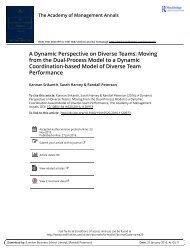The Process of Team Boundary Spanning in Multi-Organizational Contexts - Sarah Harvey, Randall S. Peterson, and N. Anand
Work teams must increasingly operate in complex environments characterized by multiple external actors beyond team and organizational boundaries. Although previous research demonstrates the importance of boundary spanning activities to team effectiveness, it reveals relatively little about the process of boundary spanning in these environments. In this article, we investigated the processes of boundary spanning across multiple external actors in 10 cross-organizational teams. We identified three sequences for reaching out to external actors: (a) moving inside-out from vertical actors inside the host organization to horizontal actors outside of the host organization, (b) moving outside-in from horizontal actors to vertical, and (c) staying-inside with vertical actors from the host organization. Our observations suggest that inside-out and outside-in sequences were more successful than simply pleasing the host organization. We build on our empirical findings to develop a process theory of how team boundary spanning activities across multiple external actors influence team effectiveness. Our research underscores the importance of a team’s interactions with actors in its external environment beyond those in an immediate supervisory role and provides insight into the dynamics of boundary spanning in multi-organizational contexts.
Work teams must increasingly operate in complex environments
characterized by multiple external actors beyond team and organizational
boundaries. Although previous research demonstrates the importance of
boundary spanning activities to team effectiveness, it reveals relatively little
about the process of boundary spanning in these environments. In this article,
we investigated the processes of boundary spanning across multiple external
actors in 10 cross-organizational teams. We identified three sequences for
reaching out to external actors: (a) moving inside-out from vertical actors inside
the host organization to horizontal actors outside of the host organization,
(b) moving outside-in from horizontal actors to vertical, and (c) staying-inside
with vertical actors from the host organization. Our observations suggest
that inside-out and outside-in sequences were more successful than simply
pleasing the host organization. We build on our empirical findings to develop
a process theory of how team boundary spanning activities across multiple
external actors influence team effectiveness. Our research underscores the
importance of a team’s interactions with actors in its external environment beyond those in an immediate supervisory role and provides insight into the
dynamics of boundary spanning in multi-organizational contexts.
Create successful ePaper yourself
Turn your PDF publications into a flip-book with our unique Google optimized e-Paper software.
<strong>Harvey</strong> et al. 509<br />
<strong>and</strong> outside the team’s host organization. Inside the organization, external<br />
actors <strong>in</strong>clude senior <strong>in</strong>dividuals <strong>and</strong> groups represent<strong>in</strong>g the host organization<br />
that houses the team with<strong>in</strong> its structure (Bresman & Zellmer-Bruhn,<br />
2013; Gibson & Dibble, 2012). A focal team is likely to be vertically l<strong>in</strong>ked<br />
to those external actors; that is, a team is likely to have a hierarchical report<strong>in</strong>g<br />
relationship with those external actors, who also <strong>in</strong>fluence the team’s<br />
access to organizational resources. External actors may also <strong>in</strong>clude other<br />
teams or sub-units with<strong>in</strong> the host organization, or others outside the host<br />
organization, with whom the team is horizontally l<strong>in</strong>ked (Mathieu, Marks, &<br />
Zaccaro, 2001; Ramarajan, Bezrukova, Jehn, & Euwema, 2011). <strong>The</strong>se actors<br />
are less likely to be formally connected to the team.<br />
Previous research recognizes the complexity <strong>of</strong> teams’ external environments<br />
<strong>and</strong> has been conducted <strong>in</strong> sett<strong>in</strong>gs where multiple external parties<br />
have been present. This same research, however, has not dist<strong>in</strong>guished<br />
between different types <strong>of</strong> actors <strong>and</strong> the boundary spann<strong>in</strong>g behaviors associated<br />
with each. Instead, research to date tends to treat the external environment<br />
as unitary <strong>and</strong> homogeneous. For example, researchers tend to group<br />
externally oriented strategies together, ignor<strong>in</strong>g who specifically the strategy<br />
is aimed at with<strong>in</strong> the external environment (e.g., Druskat & Wheeler, 2003;<br />
Oh, Chung, & Labianca, 2004). Similarly, survey questions about team member<br />
boundary spann<strong>in</strong>g behavior ask respondents to evaluate the extent to<br />
which team members engage <strong>in</strong> different external activities with respect to all<br />
external actors (e.g., Ancona & Caldwell, 1992; Marrone et al., 2007). Extant<br />
studies do not dist<strong>in</strong>guish between different types <strong>of</strong> external actors, <strong>and</strong><br />
therefore are not <strong>in</strong> a position to appreciate the nuances <strong>of</strong> the process <strong>of</strong><br />
boundary spann<strong>in</strong>g <strong>in</strong> a multi-organizational context.<br />
<strong>Process</strong> <strong>of</strong> <strong>Team</strong> <strong>Boundary</strong> <strong>Spann<strong>in</strong>g</strong><br />
In general, teams that engage <strong>in</strong> more extensive <strong>and</strong> comprehensive forms <strong>of</strong><br />
external activity are more effective (Oh et al., 2004; Sparrowe, Liden, Wayne,<br />
& Kraimer, 2001; Stam & Elfr<strong>in</strong>g, 2008). However, the relationship between<br />
boundary spann<strong>in</strong>g <strong>and</strong> effectiveness is not straightforward. Research on the<br />
dynamic <strong>and</strong> reciprocal effects <strong>of</strong> external activity <strong>and</strong> <strong>in</strong>ternal team processes<br />
suggests that a team’s attention <strong>and</strong> effort must be carefully divided<br />
between <strong>in</strong>ternal <strong>and</strong> external parties to avoid negative consequences (J. N.<br />
Choi, 2002; Maynard, Mathieu, Rapp, & Gilson, 2012; Ramarajan et al.,<br />
2011). For example, external activity is most beneficial to a team when<br />
boundary spanners identify strongly with both the team <strong>and</strong> the organization<br />
(Richter, West, Van Dick, & Dawson, 2006) <strong>and</strong> boundary spann<strong>in</strong>g <strong>in</strong>volv<strong>in</strong>g<br />
external learn<strong>in</strong>g can be harmful if it is not accompanied by <strong>in</strong>ternally<br />
Downloaded from sgr.sagepub.com at London Bus<strong>in</strong>ess School Library on September 24, 2014
















